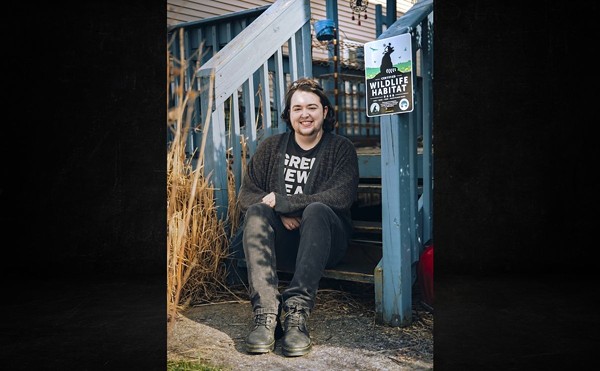Carl Solway Gallery has obtained Robert Kushner’s The Four Seasons murals from downtown’s Tower Place mall and is showing them with recent paintings by the New York artist in the exhibit Robert Kushner: Paintings 2010-2013 & The Four Seasons.
Commissioned in 1990, Kushner’s 9-by-27-foot triptychs hung in Tower Place’s atrium more than two stories above the food court. Maybe you never noticed the murals, or you recall them but not the mall’s stores and eateries. Tower Place opened in 1991 but in recent years became a ghost town, and plans were recently set in motion to turn it into a garage with street-level retail that will be called Mabley Place.
At eye level in the Solway Gallery, Kushner’s The Four Seasons paintings can be (re)appreciated as works of art and not remnants of a dying retail landscape. For the first time, it’s possible to see the bits of glitter and sequins used. No longer does each composition feel like a flat banner.
Kushner agrees that the paintings look better viewed head-on.
“I’d forgotten about the layers of paint, the translucence,” the artist says. “You can get your nose up to them.” Indeed, you can almost smell the evergreen needles in “Winter” and breathe in the frosty air.
It wasn’t easy to bring the outdoors in. The three 9-by-9 panels that make up each season were too wide to fit through the Solway Gallery doors. Associate director Anita Douthat says the stretcher on the back of each had to be cut so the canvas could be gently folded. Their removal and transportation was a two-day process with development company JDL Warm Construction.
The Four Seasons commission grew out of Kushner’s visit here for the Contemporary Arts Center’s 50th anniversary in 1989. (Kushner was part of the CAC’s 1978 show Arabesque.) He met then-director Dennis Barrie, who was scouting for Tower Place’s developers. In addition to the murals, Kushner created a bronze flower sculpture for the food court fountain, which was not saved before demolition.
Kushner remembers the optimism surrounding Tower Place. “We all assumed it would be there forever,” he says. He compared its eventual unpopularity to “a 20-year-old car that’s not yet vintage. You no longer want to drive it.” The removal of commissioned pieces happens a lot, he says. This is his third experience.
Once the paintings were moved from Tower Place, there remained the matter of finding walls big enough to hang them, even in the 12,500-square-foot former warehouse building that constitutes the Solway Gallery. “Winter” hangs across from the tulips of “Spring” in project space across from the main gallery. The red and white geraniums of “Summer” bloom in the gallery’s south wing, and the golds and browns of “Fall” are the first sight in the north room. The arrangement does provide an opportunity to consider each work on its own and compare them to Kusher’s paintings from 2010-2013, also on display.
The Pasadena, Calif.-born Kushner was a founder of the Pattern and Decoration movement in the mid-1970s. By 1985, however, the style was dismissed by critics as too feminine or trivial. Kushner laments that if an artist focuses on beauty, he or she is thought to be “mentally deficient.” He says his goal is to create a positive experience that sustains the observer.
Kushner’s love of pattern is more apparent in his smaller paintings in the gallery, especially in works outlining flowers over Japanese screens and antique papers and other pieces incorporating mandala imagery. His use of gold and silver leaf is a reminder that earth’s gardens are as precious as these metals. What’s outside our homes is as special as what we choose to bring inside. Yet Kushner’s “O Peony” series and other collages are busy, and the flowers disappear into the mix. The details found on the various pages of sheet music, seed packs, advertisements and labels used in the collages become distracting. The harmony between natural and manmade beauty is lost. And enjoying just one or the other is not Kushner’s intent.
As a proponent of decorative art, Kushner hopes The Four Seasons works will end up where people can live with and enjoy them daily. “Likely they can be in a lobby,” he muses, taking their size into consideration, “or a hospital — for a sense of nature.”
ROBERT KUSHNER: PAINTINGS 2010-2013 & THE FOUR SEASONS continues through April 12 at Carl Solway Gallery, 424 Findlay St., West End, 513-621-0069, solwaygallery.com.





